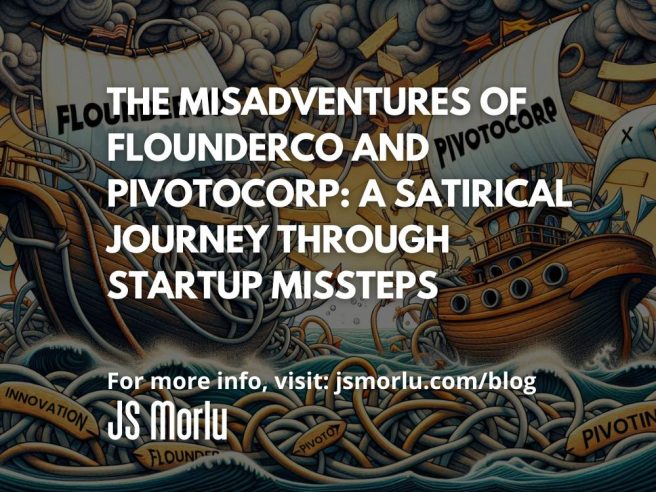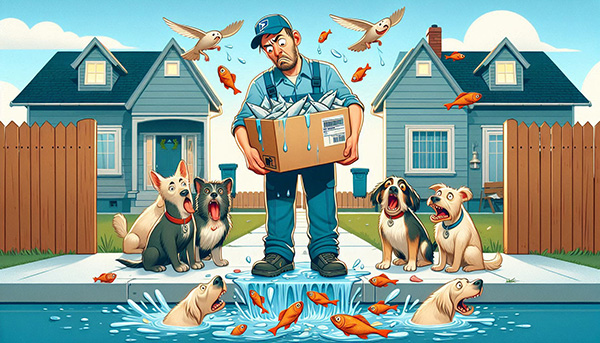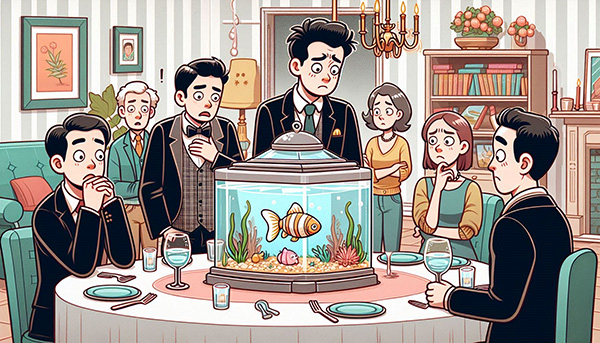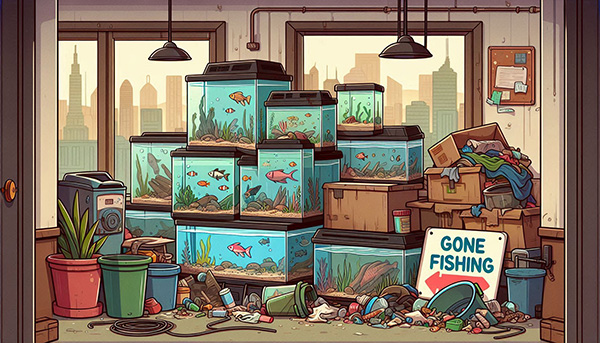By: John S. Morlu II, CPA
Introduction: Navigating the Startup Storm
In the chaotic whirlpool of the startup universe, where every day feels like an intense game of Monopoly mixed with Mad Libs and a dash of roulette, buzzwords such as “business model innovation” and “pivoting” are tossed around like confetti at a New Year’s Eve party. These terms are the glittering promises of Silicon Valley, suggesting that with the right mix of jargon and enthusiasm, startup blunders can magically morph into success stories overnight. But let’s face it—many fresh-faced entrepreneurs find these buzzwords as clear as a foggy morning in San Francisco, where the line between a breakthrough and a breakdown is as thin as the city’s famous mist.
The cold, hard truth is that without a deep and practical understanding of these concepts, startups are like ships sailing without a compass—destined to flounder in the murky waters of obscurity. Enter our protagonists: FlounderCo and PivotoCorp. These are not your average startups; they are fictional titans of entrepreneurial misadventure, each with grand ambitions and spectacularly entertaining failures.
FlounderCo, with its ill-fated fish tank subscriptions, and PivotoCorp, with its whimsical color-matching dating app, offer a satirical lens on the often bewildering world of business model innovation and pivoting. Their tales are not just fodder for laughter but serve as cautionary reminders of what can go awry when these concepts are misunderstood or misapplied.
Join us as we embark on a satirical journey through their misadventures. We’ll revel in their humorous blunders, explore their epic failings, and, most importantly, uncover valuable lessons to help you navigate the treacherous seas of startup life. Buckle up and prepare for a wild ride through the absurd and enlightening world of entrepreneurial folly.
Chapter 1: FlounderCo—The Fish Out of Water
The Visionary Fish Tank
Bertie Flounder, an affable fellow with more enthusiasm than sense, proudly crowned himself the “aquatic visionary” of the startup world. His brainchild, FlounderCo, was a daring plunge into the murky depths of the fish tank market. Bertie’s grandiose plan was to launch a subscription service where, every month, subscribers would receive an exotic new fish and a tank so exquisitely designed it could have been sculpted by Poseidon himself.
FlounderCo’s business model innovation was a masterstroke of genius—or so Bertie believed. He was convinced that people were clamoring for the chance to welcome a new finned friend into their homes on a monthly basis. Unfortunately, Bertie’s grasp of the market was as shallow as a puddle after a light drizzle. His vision was dazzlingly impractical, like planning a tropical beach vacation in the middle of the Arctic winter.
The Logistics Nightmare
The first sign of trouble emerged when Bertie’s ambitious logistics plan collided with reality. Fish, it turns out, aren’t particularly fond of travel. Imagine the chaos: a box of wriggling, gasping fish making their way to suburban doorsteps, their aquatic home replaced with a bumpy ride through the postal system. The delivery folks weren’t exactly thrilled to play impromptu aquarists, and the neighborhood dogs took an instant liking to the fishy parcels.
And let’s not forget Bertie’s so-called “luxury” tanks. They were touted as masterpieces of modern design but ended up being more suitable as overpriced coffee tables. Sure, they looked nice, but they had all the functionality of a hollowed-out pumpkin. The tanks were less a sanctuary for aquatic life and more a stylish way to make your living room look like a very expensive fish museum.
The Marketing Misstep
Bertie’s marketing strategy was as misguided as a GPS system stuck in reverse. FlounderCo was advertised as providing “the ultimate conversation starter,” but it quickly became clear that the only conversations it sparked were of confusion and regret. Bertie’s pitch promised a fish tank so dazzling that it would make dinner parties unforgettable. Instead, the tanks became a point of awkward silence, where guests wondered why their host had suddenly become a collector of decorative, non-functional water features.
In an ironic twist, Bertie’s Aunt Mabel was the only subscriber to FlounderCo. She didn’t care for fish and wasn’t particularly fond of Bertie’s entrepreneurial zeal. She merely signed up to be supportive, turning her living room into a shrine of dust-gathering tanks and disgruntled fish. Aunt Mabel’s basement soon resembled a forgotten aquarium exhibit, complete with a “Gone Fishing” sign of its own.
The Ultimate Flounder
In the end, FlounderCo’s failure was not a result of a lack of creativity but rather an utter disconnect from the realities of market demand and practical execution. Bertie’s grand vision, while impressive in its ambition, was a classic example of innovation without insight. The company created a product nobody wanted, resulting in a spectacular flop that left a trail of discarded fish tanks and bemused customers in its wake.
FlounderCo’s story serves as a poignant reminder that even the most visionary ideas can quickly flounder when they are out of touch with actual needs and practicalities. Bertie Flounder’s aquatic escapade ended up as little more than a cautionary tale of a startup that dove headfirst into the deep end without checking if there was any water in the pool.
Chapter 2: PivotoCorp—The Pivot Fiasco
From Sandwiches to Colors
Regina Pivot, a self-described “matchmaking maven,” launched PivotoCorp with what she believed was a revolutionary idea for the dating app world. Her initial brainchild, “Romantica,” sought to connect users based on their favorite sandwiches. Yes, you read that right: a dating app where compatibility was measured by culinary preferences, specifically, the type of sandwich one preferred. Regina envisioned love blossoming over shared fondness for pastrami on rye or an artisanal avocado toast.
The concept sounded quirky and original—at least in Regina’s enthusiastic pitch meetings. “Find love between bites!” she declared. Unfortunately, it turns out most people are more interested in finding a romantic connection than debating the merits of a classic BLT versus a grilled cheese. Romantic dreams and lunchtime preferences seemed to be a pairing that not even the most ardent foodies could stomach.
The Great Pivot
Realizing that her sandwich-centric app wasn’t winning hearts or attracting users, Regina decided it was time for a bold pivot. And what better way to reinvent a dating app than by focusing on another utterly arbitrary factor: color preferences! With all the zeal of someone who’s just discovered a new flavor of ice cream, Regina shifted Romantica’s core focus from sandwiches to hues.
In a move that could be described as “pivoting for pivot’s sake,” PivotoCorp morphed into an app where potential matches were determined by their favorite colors. Users could now seek their soulmates based on a palette of shades—because who wouldn’t want to find true love through a virtual spectrum? The app was promptly rebranded to “ColorMeLove,” and Regina proudly declared that love was only a shade away.
The Colorful Disaster
Regina’s colorful pivot did little to improve user engagement. Instead of brightening up the app’s prospects, it merely added a layer of confusion. Users were left scratching their heads, trying to understand why their ideal partner was being determined by something as subjective as color preference. The “mood ring” feature, which was intended to assess users’ emotional states, only further compounded the chaos. The app’s interface became a psychedelic swirl of hues and moods, leaving users feeling like they were navigating a dating app designed by Salvador Dalí.
As one user lamented, “I thought I was swiping right on someone who liked green, but it turns out they just liked green M&Ms. Now I’m matching with people whose favorite color is ‘rainbow.’” The app’s attempts at integrating astrology, aura readings, and “mood lighting” features didn’t do much to rescue it from its downward spiral into obscurity.
The Pivot Trap
PivotoCorp’s primary issue wasn’t pivoting itself; it was the relentless shifting without addressing the fundamental problem: a clear lack of product-market fit. Each pivot was less about refining a concept and more about avoiding the deep-seated issues with Regina’s original idea. The sandwich-to-color transformation was akin to rearranging deck chairs on the Titanic.
Regina’s story is a colorful cautionary tale about how constant pivoting, without a coherent strategy or understanding of market needs, can lead to an even bigger mess. Her journey through mismatched sandwiches and confusing color schemes serves as a humorous yet sobering reminder that pivoting should be more than a frantic reaction to failure; it should be a strategic realignment based on genuine insights and user feedback.
So, while Regina Pivot may have pivoted her way through a spectrum of ill-conceived ideas, her tale is a vivid illustration of the dangers of misunderstanding pivoting. Sometimes, when your product doesn’t hit the mark, it’s not about changing the flavor or hue—it’s about finding out what your audience truly needs, and perhaps, not getting caught up in the rainbow of misguided solutions.
Conclusion: The Lessons of FlounderCo and PivotoCorp—A Comedy of Errors with Serious Consequences
The escapades of FlounderCo and PivotoCorp serve as both a comedic romp and a cautionary fable in the turbulent seas of entrepreneurship. These tales of misguided innovation and errant pivots are not just humorous anecdotes but also potent reminders of the fundamental principles of startup success.
FlounderCo’s grand misadventure highlights a critical lesson: creating a solution for a problem that doesn’t exist is like building a luxury fish tank for a desert. Bertie Flounder’s enthusiasm for his exotic fish subscription service was admirable, but his inability to grasp the market’s true needs led to an epic flop. His tanks became a testament to the dangers of innovating in a vacuum—where ideas, no matter how grand, fail to resonate when they’re disconnected from real-world demand.
On the other side of the spectrum, PivotoCorp’s story is a colorful spectacle of constant change without any meaningful progress. Regina Pivot’s ceaseless shifts from sandwich matchmaking to color-based compatibility might have seemed like a creative dance, but in reality, they were steps in a cha-cha of confusion. Her relentless pivots, while entertaining, showcased the peril of changing direction without addressing the core issues of product-market fit. It’s a vivid reminder that pivoting isn’t just about turning on a whim—it’s about recalibrating your course with precision based on genuine insights and feedback.
In the startup realm, true innovation isn’t about having the flashiest idea or the most eccentric concept. It’s about solving real problems in a way that resonates with your audience and delivers practical value. Innovation requires a deep dive into market needs and a commitment to practical execution. Similarly, pivoting should be a strategic response, not a knee-jerk reaction. It’s about adjusting your approach thoughtfully, not spinning around in a whirlwind of constant change.
So, aspiring entrepreneurs, let the follies of Bertie Flounder and Regina Pivot serve as your guideposts. Innovate with purpose, ensuring that your ideas address genuine needs and have a solid foundation in market reality. When it comes to pivoting, make sure your changes are informed by meaningful feedback and a clear strategy, rather than a series of hasty decisions.
As you embark on your entrepreneurial voyage, remember that while FlounderCo and PivotoCorp may be fictional, their lessons are all too real. Let their blunders be the compass that steers you clear of the pitfalls of misguided innovation and erratic pivots. Here’s to your startup adventure—may it be less of a farce and more of a flourishing success story. Happy innovating, pivoting, and navigating the exciting world of entrepreneurship!
Author: John S. Morlu II, CPA is the CEO and Chief Strategist of JS Morlu, leads a globally recognized public accounting and management consultancy firm. Under his visionary leadership, JS Morlu has become a pioneer in developing cutting-edge technologies across B2B, B2C, P2P, and B2G verticals. The firm’s groundbreaking innovations include AI-powered reconciliation software (ReckSoft.com) and advanced cloud accounting solutions (FinovatePro.com), setting new industry standards for efficiency, accuracy, and technological excellence.
JS Morlu LLC is a top-tier accounting firm based in Woodbridge, Virginia, with a team of highly experienced and qualified CPAs and business advisors. We are dedicated to providing comprehensive accounting, tax, and business advisory services to clients throughout the Washington, D.C. Metro Area and the surrounding regions. With over a decade of experience, we have cultivated a deep understanding of our clients’ needs and aspirations. We recognize that our clients seek more than just value-added accounting services; they seek a trusted partner who can guide them towards achieving their business goals and personal financial well-being.
Talk to us || What our clients says about us










